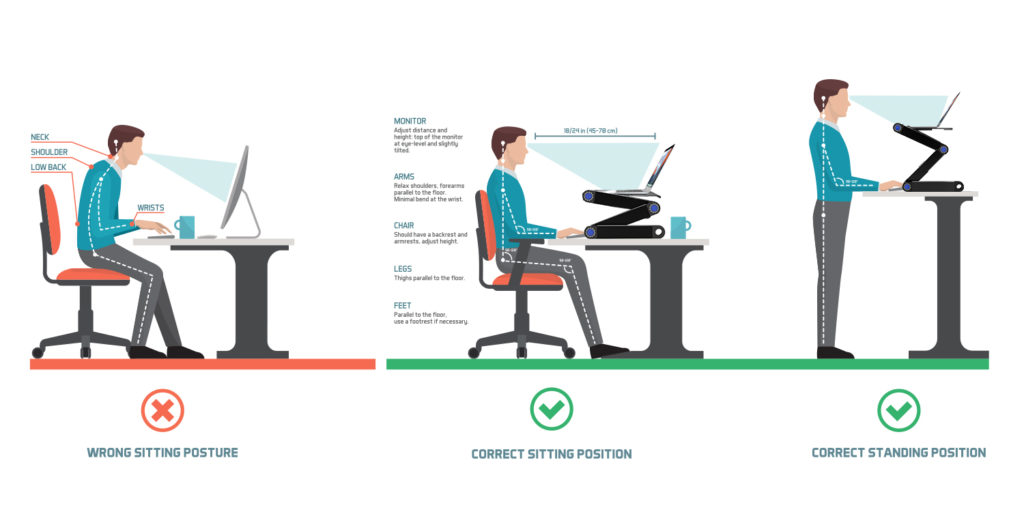Excessive screen time can lead to a condition called computer eye strain (CES). This is sometimes known as computer vision syndrome, or digital eye strain. It occurs because our eyes have to work hard when viewing screens. Therefore, in this article we will explain about the symptoms and solutions for computer eye strain.

Many individuals experience eye discomfort and vision problems when viewing digital screens for extended periods. The level of discomfort appears to increase with the amount of digital screen use. It seems everyone is staring at a computer screen, phone or other digital device these days. And it’s causing a serious problem called digital eye strain.
What are the symptoms?
While not causing any permanent damage, common symptoms of CES can cause a lot of discomfort and irritation in the short term. These symptoms include:
- Eye fatigue
- Physical tiredness
- Eye twitching
- Red eyes
- Watery eyes
- Dry eyes
- Increased sensitivity to light
- Blurry vision
- Trouble focusing
In addition, use of digital screens often limits the amount of time that we blink, therefore denying our eyes the hydration they need to stay moist and healthy. Dry eye syndrome is when our eyes have become dried out, as a result of tear ducts no longer producing adequate natural tears that our eyes need.
What are the solutions?
Tips for computer work
Computer use is a common cause of eyestrain. If you work at a desk and use a computer, these self-care steps can help take some of the strain off your eyes.
- Blink often to refresh your eyes – Many people blink less than usual when working at a computer, which can contribute to dry eyes. Blinking produces tears that moisten and refresh your eyes. Try to make it a habit to blink more often when looking at a monitor.
- Take eye breaks – Throughout the day, give your eyes a break by looking away from your monitor. Try the 20-20-20 rule: Every 20 minutes, look at something 20 feet away for at least 20 seconds.
- Check the lighting and reduce glare – Bright lighting and too much glare can strain your eyes and make it difficult to see objects on your monitor. The worst problems are generally from sources above or behind you, including fluorescent lighting and sunlight. Consider turning off some or all of the overhead lights. If you need light for writing or reading, use an adjustable desk lamp. Close blinds or shades, and avoid placing your monitor directly in front of a window or white wall. Place an anti-glare cover over the screen.
- Adjust your monitor – Position your monitor directly in front of you about an arm’s length away so that the top of the screen is at or just below eye level. It helps to have a chair you can adjust too.
- Use a document holder – If you need to refer to print material while you work on your computer, place it on a document holder. Some holders are designed to be placed between the keyboard and monitor; others are placed to the side. Find one that works for you. The goal is to reduce how much your eyes need to readjust and how often you turn your neck and head.
- Adjust your screen settings – Enlarge the type for easier reading. And adjust the contrast and brightness to a level that’s comfortable for you.

Tips for lifestyle and home remedies
- Adjust the lighting – When watching television, it may be easier on your eyes if you keep the room softly lit. When reading printed materials or doing close work, try to position the light source behind you and direct the light onto your page or task. If you’re reading at a desk, use a shaded light positioned in front of you. The shade will keep light from shining directly into your eyes.
- Take breaks – When doing close work, take occasional breaks and rest your eyes by looking away from the digital screen.
- Limit screen time – This is especially important for children, who may not make the connection between extended viewing, eyestrain and the need to rest their eyes regularly.
- Use artificial tears – Over-the-counter artificial tears can help prevent and relieve dry eyes. Use them even when your eyes feel fine to keep them well-lubricated and prevent a recurrence of symptoms.Your doctor can suggest which eyedrops might be best for you. Lubricating drops that don’t contain preservatives can be used as often as you need. If the drops you’re using contain preservatives, don’t use them more than four times a day. Avoid eyedrops with a redness remover, as these may worsen dry eye symptoms.
- Improve the air quality of your space – Some changes that may help prevent dry eyes include using a humidifier, adjusting the thermostat to reduce blowing air and avoiding smoke. If you smoke, consider quitting. Moving your chair to a different area may help reduce the amount of dry moving air on your eyes and face.
- Choose the right eyewear for you – If you need glasses or contacts and work at a computer, consider investing in glasses or contact lenses designed specifically for computer work. Ask your optometrist about lens coatings and tints that might help too.
Go for an eye exam
Having regular eye tests will not only ensure clear and comfortable vision but will also address other eye health issues and medical conditions. If you use a digital device every day at work, your employer is under obligation to fund your eye exam as stipulated by the Health and safety Regulations 1992.
You should inform your optometrist of your computer use when you go for your eye test so that they can take this into consideration. They may even ask whether you use a computer, how it is set up and how much time you spend on digital devices each day. Book your appointment with us today!


